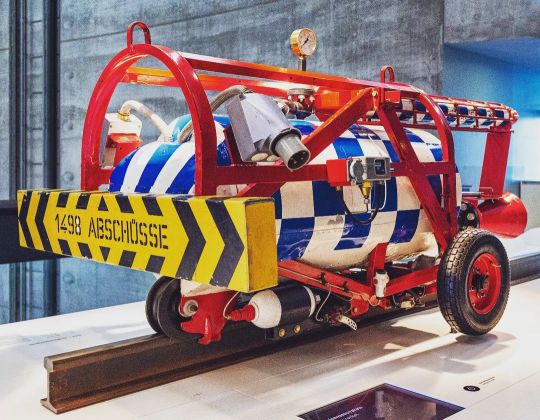#mercedessafety
Photo

Mercedes-Benz Experimental Safety Vehicle ESF 22 - Mercedes-Benz Museum Stuttgart . The Experimental Safety Vehicle ESF 22 was the third milestone in Mercedes-Benz’s ESV Program. This international research program sought to improve the safety standards in automobiles. Thanks to airbags and belt tensioners, the ESF 22 gave the occupants a good chance of survival in the event of a head-on impact against a rigid barrier at 40 mph. Cylinders V8 Displacement 276 cu in Output 143 kW at engine speed 4500/min Production period 1973 Units produced 1 #mercedes #mercedesbenz #mercedesesf #mercedesv8 #mercedessafety #experimentalsafetyvehicle #mercedeslife #mercedeslifestyle #mercedesheritage #classiccars #classiccar #luxurycars #traveling #travelgram #travel #enjoyinglife #carmuseum #museum #luxury #mercedesmuseum #airbag #research #bestcars #vintagecars #esf #luxuryvehicle #photooftheday #history #carhistory #oldtimers (at Mercedes-Benz Museum) https://www.instagram.com/p/Cnsjt9XoBZ3/?igshid=NGJjMDIxMWI=
#mercedes#mercedesbenz#mercedesesf#mercedesv8#mercedessafety#experimentalsafetyvehicle#mercedeslife#mercedeslifestyle#mercedesheritage#classiccars#classiccar#luxurycars#traveling#travelgram#travel#enjoyinglife#carmuseum#museum#luxury#mercedesmuseum#airbag#research#bestcars#vintagecars#esf#luxuryvehicle#photooftheday#history#carhistory#oldtimers
1 note
·
View note
Photo

Mercedes-Benz rusza z programem szkoleń bezpiecznej jazdy – Mercedes-Benz Safety Experience
Flota pojazdów:
- Nowa Klasa A
- CLA Coupe
- CLA Shooting Brake
- Klasa C Kombi
- GLC SUV
- Klasa E limuzyna
- Klasa E All-Terrain
Więcej na stronie 👉 http://nowoscimotoryzacyjne.pl/samochody/mercedes/250-mercedes-benz-rusza-z-programem-szkolen-bezpiecznej-jazdy-mercedes-benz-safety-experience
#mercedes#mercedesbenz#mercedessafety#benz#samochody#samochód#polska#poland#auto#auta#automotive#car#cars#carnews#carsnews#motoryzacja#motopasja#motonews
60 notes
·
View notes
Photo

1962 "Propulsion System" for crash test vehicles - Mercedes-Benz Museum The first crash test of Mercedes-Benz car happened on September 10, 1959. The car collided against a 17-ton obstacle. Mercedes-Benz 190 with a “tail fin body” of this first crash test was set into motion with the help of a winch that was actually made for launching gliders. The cable was separated from the vehicle right before the crash, so that a force from the cable would not affect the actual collision. In later tests, the developers sometimes used a second car that pushed the test vehicle forward from behind. This first test was followed by more frontal collisions against a rigid obstacle. The next stage of development came in 1962 when somebody had the mind-blowing idea of conducting a crash test with a rocket engine, according to Gerhard Heidbrink, who works in the archives of Mercedes-Benz Classic. “In 1962 the developers further standardised the propulsion of the test vehicle by employing a kind of hot-water rocket as the drive system,” he says. “They simply filled water into a boiler and heated it to 260 degrees Celsius in order to generate an enormous amount of pressure. As soon as they opened the valve, the super-heated water vapor shot out through a nozzle,” explains Heidbrink. “The whole thing acted like a rocket.” As soon as the vehicle achieved the right speed, it was disconnected and the rocket was braked. Information: Mercedes-Benz Magazine for Mobility and Society #mercedes #mercedesbenz #mercedessafety #carsafety #sedan #mercedeslife #mercedeslifestyle #mercedesheritage #classiccars #classiccar #luxurycars #traveling #travelgram #travel #enjoyinglife #carmuseum #museum #luxury #mercedesmuseum #luxurysedan #crashtest #bestcars #vintagecars #crashtest #luxuryvehicle #photooftheday #history #carhistory #oldtimersday (at Mercedes-Benz Museum) https://www.instagram.com/p/CnC86ZIIQy_/?igshid=NGJjMDIxMWI=
#mercedes#mercedesbenz#mercedessafety#carsafety#sedan#mercedeslife#mercedeslifestyle#mercedesheritage#classiccars#classiccar#luxurycars#traveling#travelgram#travel#enjoyinglife#carmuseum#museum#luxury#mercedesmuseum#luxurysedan#crashtest#bestcars#vintagecars#luxuryvehicle#photooftheday#history#carhistory#oldtimersday
0 notes